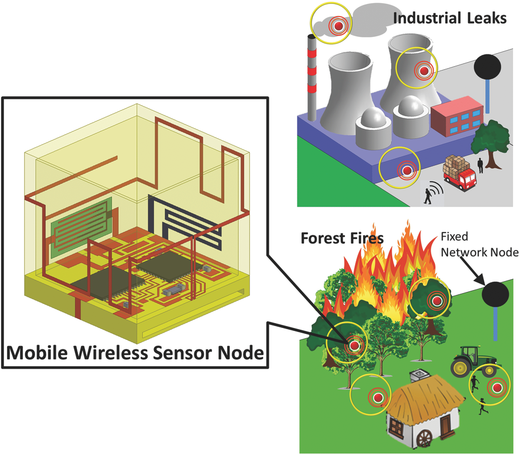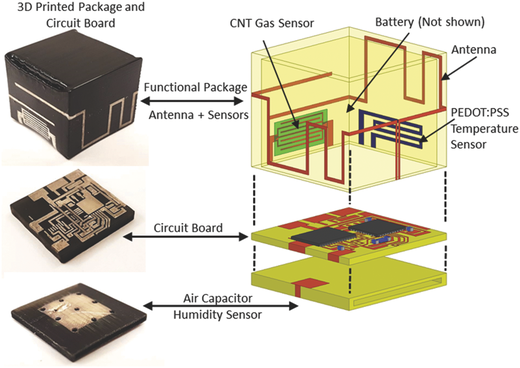Developing disposable lifesaving sensors

Atif Shamim, KAUST associate professor of electrical engineering, works on smart sensor systems with his research group in the IMPACT Lab. Photo by Meres J. Weche.
-By David Murphy, KAUST News
Large area environmental monitoring can play a crucial role in dealing with crisis situations, such as forest fires or industrial gas and chemical leaks. Forest fires alone are responsible for thousands of fatalities worldwide every year and exposure to the unmonitored emission of toxic gases in industrialized and remote regions can also lead to fatalities and lifelong health issues.
Existing early warning environmental monitoring systems rely on satellite monitoring, watchtowers or expensive fixed sensors. Fixed network infrastructure can be implemented in specific areas, but installing such networks over large areas is not practical as the cost of installation becomes unreasonably high, especially in remote areas.
A group of KAUST researchers is seeking to address these environmental and high-cost concerns through the development of a low-cost, 3-D printed reliable node system. The system, developed by a team of researchers led by Associate Professor of Electrical Engineering Atif Shamim, works by saturating high-risk areas with disposable sensor nodes linked wirelessly to a few fixed nodes that raise the alarm. The smart sensor system is capable of detecting noxious gases and changes in temperature and humidity that could revolutionize environmental monitoring.
Atif Shamim, KAUST associate professor of electrical engineering, and his students work on cutting-edge research in flexible, wearable and disposable wireless sensors with industrial, biomedical and environmental applications. Photo by Meres J. Weche.
Low cost in real-time
Designed by KAUST Ph.D. student Muhammad Farooqui, the node has been tested in both the laboratory and in the field. It survives being dropped and subjected to temperatures up to 70°C, which, Shamim said, "is good enough to give an early warning in cases of wildfire." He believes it is the first "low-cost, fully integrated, packaged, 3-D-printed wireless sensor node for real-time environmental monitoring."
"We call this additive manufacturing. With our design, we wanted to stay completely digital so there is no material wasted because we only print material when it's required. That is why it is called additive manufacturing. The key is to do disposable low-cost sensors, and at KAUST, we have access to a variety of excellent printers that can print on inexpensive materials like plastic, different types of paper and other kinds of material," Shamim emphasized.
"Before coming to KAUST, I was working in Canada on traditional wireless electronics that are rigid, bulky and expensive," Shamim said. "When I came to KAUST, I saw a printer in the Core Labs facilities, and that is where my journey with printed electronics started."
"In the last five years, we have established a great printed-electronics setup with the generous support provided by KAUST. We have been involved in all kinds of printing—3-D printing, inkjet printing and screen printing. In our lab—the IMPACT Lab—we like to do flexible, disposable, wearable and stretchable wireless sensing systems," he added.
Utilizing cutting-edge technology
Through their ongoing studies, Shamim and Farooqui have found that 3-D printing and inkjet printing can be uniquely combined in order to realize a cheap, fully integrated wireless sensor node.
The inkjet-printed sensors and antenna are realized on the walls of a 3-D-printed cubic package, which encloses the microelectronics developed on a 3-D-printed circuit board. These small-node sensors were inkjet-printed onto a 3-D-printed 2 cm3 node containing a battery and microelectronic circuit board along with an antenna that transmits in any direction. The sensors have been realized on the walls of the 3-D-printed package so that they are exposed to the environment. This is also the case for the capacitive humidity sensor, which has an air channel that is exposed externally. Since the sensor will be dispersed in the environment in random locations, a protective coating is required on the sensors so that they are not affected by dust, rainwater, etc. For the H2S and humidity sensor, a porous membrane can be made using inkjet printing, allowing only gas molecules to pass through it.
Atif Shamim, KAUST associate professor of electrical engineering, works on smart sensor systems with his research group. Photo courtesy of Atif Shamim.
"The electronics are inside this small cube, which acts as the package for the electronics. We printed the antenna and the sensors on the walls of the package so the package becomes functional and part of the system—unlike traditional electronics packages, which only act as protectors for electronics but add no functionality. That is why we call it a System-on-Package (SoP). Moreover, we have 3-D printed the package, which is different from typical packaging done through molding or other techniques, but additive manufacturing is not used. We created specified inks for temperature, humidity and gas sensing. In this study, we are sensing H2S gas as a proof of concept, but we have the capability to sense other gases as well. This is the direction of our future work in this area to enhance the number of sensors and have the capability to sense multiple gases." Shamim said.
Inventive low-cost problem solving
The cube's wireless sensor node was 3-D printed in two parts. After inkjet printing the antenna and sensors on the wall, the microelectronics and battery were enclosed in the cube sensor. Due to additive manufacturing and custom inks made in-house, the manufacturing cost of creating the smart sensor cubes was kept extremely low. Due to the ease and low cost involved in creating this type of sensor, it could be assumed that the researchers compromised on performance or in other areas, but Shamim insists that the sensors were tested and passed the highest performance tests and criteria.

KAUST scientists’ disposable mobile wireless sensor nodes can be used to give early warning of industrial leaks or forest fires. Reproduced with permission from Farooqui et al.
"We tested the selectivity and sensitivity—two important things for sensors. Sensitivity is the ability of the sensor to detect very small changes and selectivity is the ability to differentiate between stimuli from the thing it was designed to detect and other stimuli. For example: if there is a gas leak and multiple gases are in the environment, our sensor can focus on one specific gas like H2S; it focuses solely on that gas. The selectivity and the sensitivity of our cubes are as good as the commercial (expensive) sensors—these factors were very important to us," he added.
Their research demonstrates that it is possible to develop fully integrated and packaged electronic devices using 3-D inkjet printing. It is expected that printers that can deposit metal and dielectric at the same time will be available in the near future. These printers will greatly reduce the time and steps required to develop these sensors.
Interconnectivity to aid emergency
The sensor nodes can also transmit and "talk" to each other for distances of up to 100 meters. Measurements have shown that the sensor can communicate readings of temperature, humidity and H2S levels up to a significant distance. The sensor locations can be determined based on the known location of the fixed network nodes. A suitable algorithm can be developed and programmed in the microcontroller of the sensor node to determine its location and wirelessly send it over the network.
This interconnectivity can help to create a map to aid emergency response teams in the event of any given environmental incident. For example, if there is a gas leak, you could lift a feedback mechanism that would remotely sense a gas or gases, which would then instantaneously action the switching off of a gas line or grid. 3-D-printed drones can be used to disperse the sensor nodes in remote locations and also to collect data from these nodes. Therefore, the monitoring of temperature and humidity over a large remote area like forests can help with fire incidents by issuing early warnings and providing a precise location of the early fire incident before it spreads to a large area.
"This information can be relayed back to a control room, office or person where all of the sensors at the same time can be monitored to make a judgment call. This could create a map like a heat map, a moisture map, a gas map or whatever map you want—its large area monitoring made very easy," Shamim stressed.
A drive toward the Internet of things
Shamim, whose background is in wireless electronics, sees the sensor nodes as part of a drive toward an Internet of Things (IoT) where "non-living things connected to the Internet make smart decisions for humans. Similar to the Internet being used by humans at present, where two humans are on either side of the Internet—whether it is an email or a chat message—in IoT, this communication will be between two machines," he said. An IoT approach can be developed for large area real-time monitoring of the environment that can ensure safe and healthy living.
"What is the most important character for the non-living things to have for them to behave like humans? It is sensing something and then communicating that information, and these are the two main areas we worked on—sensing and integrated wireless communication," he said.
"Eventually, the sensors connected to each other in a network could be dispersed remotely to give us gas leakage information, pollution or temperature information, etc. This is also useful for our home and office automation, such as controlling temperatures, monitoring door locks, assessing our groceries and re-ordering them, etc. These and many other such small decisions by machines will enable what we call as 'Smart Living,'" he added.
Harnessing wireless energies
The next step in the team's smart sensing research is to incorporate an energy source that will make the nodes self-sustainable in remote locations.
"A traditional way to charge or change a discharged battery is a no-no for this kind of concept. We can disperse the sensors, but going into the forest or oceans to swap out batteries constantly is not practical. What we want to do is to replace the need for constant battery changing and instead do harvesting of energy from the environment to charge the batteries. By removing the need for changing the discharged batteries, the life of these nodes can be extended considerably. For this, we need to harvest energy from the environment to charge these batteries at their respective locations through renewable sources," he noted.

The sensor node is comprised of an assembly of a 3-D-printed functional package, circuit board and the air capacitor. Reproduced with permission from Farooqui et al.
"Another future step is to make these sensor nodes through mass-producible customized chips (in place of the commercial circuit boards). This would take the cost of each sensor node to below a dollar," he said.
Building for a smart future
The KAUST researchers believe the sky's the limit for applications of their smart sensing nodes. Shamim feels that his team's technology can become an essential environmental monitoring device of the future—to make informed decisions and create a positive and efficient environmental footprint for our modern smart cities.
"I want the device to be able to monitor all gases that cause environmental pollution. Our sensors can provide cutting-edge information for a smart city—information that can be delivered and acted upon in real time. The goal is to continue to create a technology that can measure the composition of pollutant gases and that can show how much methane we're inhaling when air levels drop to unsafe levels, etc.," he emphasized.
"Our research can change how we integrate things—how we monitor things—how we live. This technology can affect our day-to-day lives because it can bring an untold smartness into the way we live," Shamim concluded.
Related stories:
- Smart sensors could save lives
- KAUST research pioneers smart sensors for better and safer living
-
Smart Bandage wins IEEE MECAP'16 Best Paper Award

